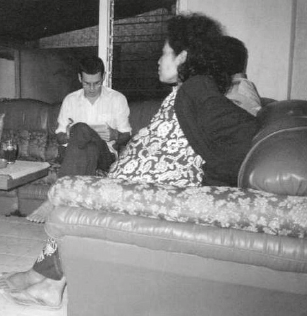Five Minutes with Nicholas Herriman September 23, 2016 15:00
If you thought witch-hunts were a thing of the 17th cenutry, think again.
In 1998, around 100 people were killed for being sorcerers in Banyuwangi, Indonesia. This figure far outnumbers the number of people who were executed during the Salem witch trials of 1692–1693, where 200 were put on trial and 20 were executed.
Nicholas Herriman, a senior lectuerer in Anthropology at La Trobe 
University, set out to find out why the killings happened as part of research for his PhD thesis between 2000-2002. His findings and arguments about the Banyuwangi incident are presented in his latest book, Witch-Hunt and Conspiracy: The ‘Ninja Case’ in East Java. We caught up with Dr Herriman to talk about witch-hunts, why anthropology is an important discipline in the study of culture and society, and his interest in podcasts (and making them).
Were the sorcerer killings in Banyuwangi the first cases to pique your interest in witchcraft and magic?
Honestly, yes! Prior to learning about the killings, my interest in Indonesia had focused on cultural performance and literature. I first heard about the sorcerer killings in 1998. The killings troubled by me. I wondered, “How could there be a witch-hunt in modern times?” I also thought, “Who was behind the killings? Who benefitted from the killings?”
These questions, it turned out, were naïve and misplaced. But I asked myself these kinds of questions. Arriving in the field in 2000, I still assumed that the witch-hunt had nothing to do with magic, but was rather tied up with national political interests. While doing fieldwork (2000–2002), I began to realise that witchcraft and magic were crucial to understanding the killings. That was the first time my interest was piqued.

In Southeast Asia today, is the belief and practice of black magic and sorcery still very common?
As far as I can tell, belief in and practice of black magic and sorcery are very common. We could qualify that statement, as academics are wont to do, by questioning what we mean by “belief”, “practice”, “magic”, and “sorcery”. Nevertheless, studies from different parts of the region report on widespread suspicions. People suspect that their neighbour, colleague, rival, or whoever it might be draws on extraordinary or unseen powers for immoral ends. The people suspected are from the heights of power to the poorest and disenfranchised.
What were the challenges you faced during your field work in Banyuwangi when you undertook the task of conducting over 100 interviews for ethnographic research?
Professionally, the fieldwork was easy. People readily admitted to killing suspected sorcerers. Indeed, in some cases, they boasted and overstated their roles! By contrast, I struggled, personally. Initially I was horrified—I had to deal with ill health and exhaustion. I kept going primarily because I thought it was crucial to get an accurate historical record this massacre; especially as press and academic reports were so misleading. I wrote Witch-hunt and Conspiracy with this objective in mind.

This woman believed she had been ensorcelled. Her protruding stomach is visible from the profile. Dr Herriman is in the background. (Photo courtesy of L. Indrawati)
What are your thoughts about interdisciplinary studies? Upon reading your book, one can see that the historical and political contexts are very important to explaining how local dynamics or reactions to a situation came about (I.e., In your book, the context of 1998 being a period of Reformasi was very important in explaining how locals were reacting to political and social change after the fall of the Suharto government).
My feeling is that context is crucial in all studies of culture and society. Nevertheless, when I compare the anthropological approach with the interdisciplinary approach, I can discern differences in how to treat this context. Based on my fieldwork, the first book I wrote is called The Entangled State. I wrote this as an anthropologist. I was concerned with how the official treatment of the “problem of sorcery” in Banyuwangi could relate to anthropological theories about the state. I contended that the state was entangled in local communities. Because of this, I argued, senior bureaucrats are hamstrung in trying to contain the “problem of sorcery”.
Witch-hunt and Conspiracy is the second book I have written from my research on the sorcerer killings. I have focused closely on the killings themselves and attempted to understand them as an interplay between local dynamics and larger developments. I see this book as an interdisciplinary study in an area studies tradition. I like a diversity of approaches. The paradox of knowing the world is that each different understanding brings both insights and limitations. So I see pros and cons to both anthropological and interdisciplinary area studies.
So how did your academic background shape the way you approached the killings?
As a philosophy student I was introduced to the skepticism of David Hume and others. I was profoundly disturbed by questions about how we know what we think we know. Of course, I have no greater insight into these problems than most people. So the skeptical attitude remained with me. In research and writing Witch-hunt and Conspiracy, I continually challenged and questioned myself. In fact, after months and months of fieldwork the patterns of the killings began to seem clearer to me. I had begun to feel there was no conspiracy behind the killings. Yet I still did not trust appearances. So, for instance, when I interviewed people I would ask, “So who was behind the conspiracy?” Assuming that the truth remains hidden from me was my modus operandi in researching Witch-hunt and Conspiracy. I wanted, as much as possible, to be sure of my findings.
You are known as the “Audible Anthropologist”, having done a podcast series about anthropological concepts. What got you thinking about doing a podcast series as a way of promoting anthropology as a field of discipline and interest? And are you thinking of doing another season of podcasts, or a new series of podcasts?
I teach anthropology at university. Some of my students coming into second year subjects are new to anthropology. I wanted a quick and easy introduction to anthropological concepts. What I found online seemed more suitable for advanced learners. So I decided to produce a crash course myself. I asked La Trobe’s Matt Smith what to do. Matt currently produces La Trobe’s Asia Rising podcasts and other publications. Matt suggested a series of podcasts entitled “The Audible Anthropologist”. I then set myself a target of recording on a concept every workday for 25 days. This would stop me from over-complicating the content. Matt also got me studio time, told me how to record, and he edited the files. I hope that the result is a simplified introduction that even high school students could use. I got great feedback about that series, so I already have another series of podcasts on iTunesU. It’s called “Witch-hunts and Persecution”. This presents an anthropological view on past and present witch-hunts. It is part of my attempt to understand what I have presented in Witch-hunt and Conspiracy, in relation to witch-hunts internationally and throughout history.
